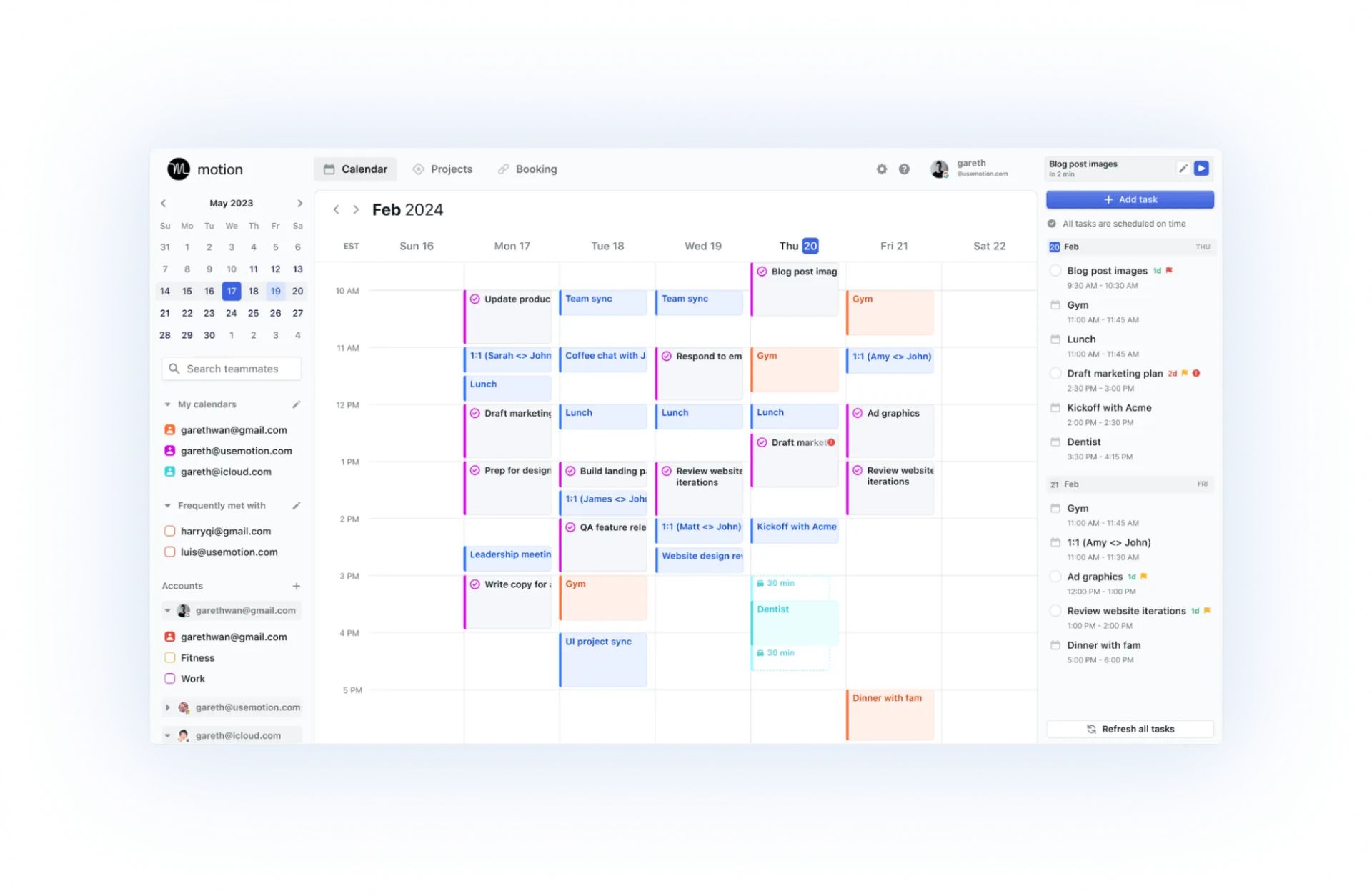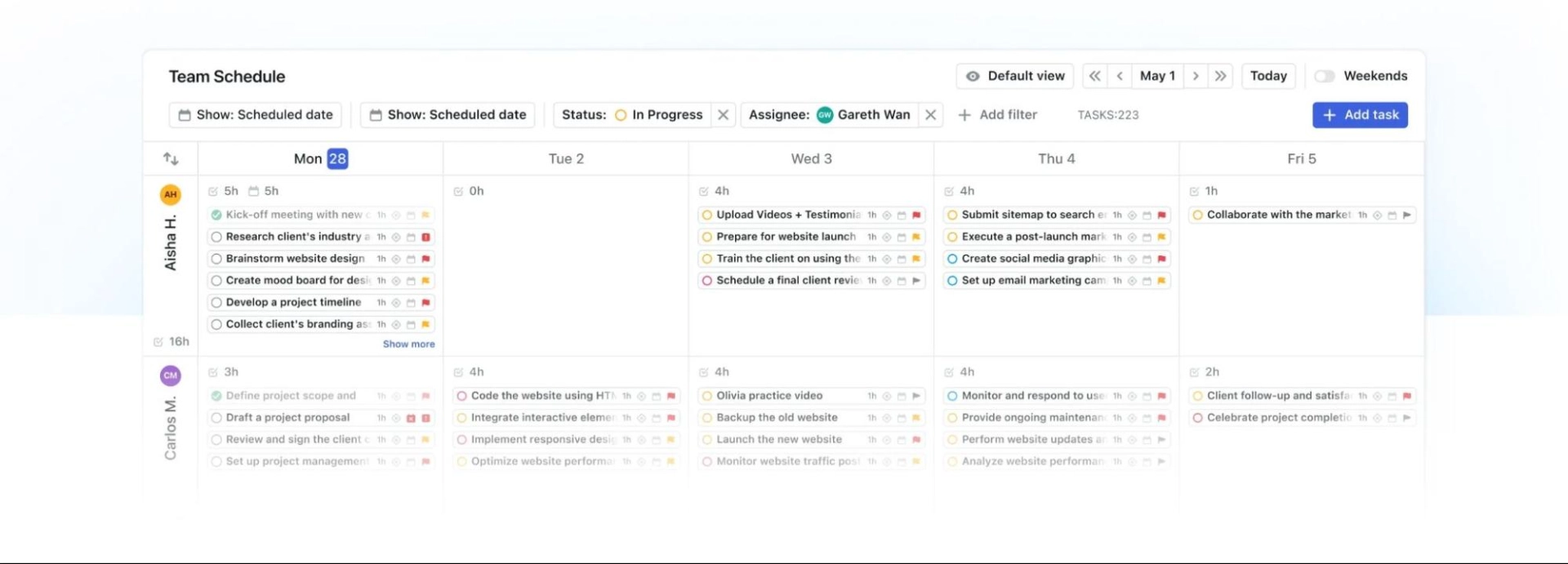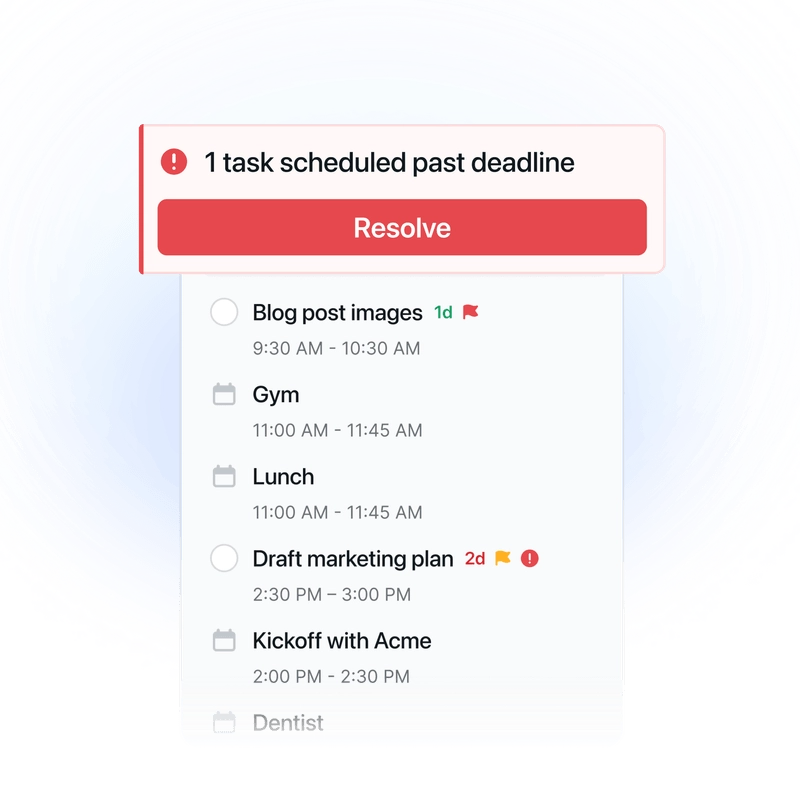Between work, deadlines, errands, and personal needs, it seems there’s just never enough time in the week to complete everything we want to.
Maintaining a healthy work-life balance can seem like another impossible task on this list. But a simple action can make a big difference: creating a weekly schedule.
Scheduling gives you control of your time so that it doesn't control you. This means more productivity at work — and free time for yourself.
In this article, we’ll show you how to create a weekly schedule that works for you, how to stick to it, and how Motion can help you do both.
What are the benefits of maintaining a weekly schedule?
Intentionally planning your week helps you achieve the following:
Better time management
A schedule creates a predictable routine. It keeps you organized, helping you stay on top of your priorities and deadlines. It also helps you break down bigger projects into bite-sized tasks.
You can also give yourself a daily allotment of time for social media and checking your personal email. These are classic time-wasting activities. But if you schedule them, you can set boundaries on when — and for how long — you’ll do them.
That will leave plenty of time for you to accomplish more important tasks on your to-do list.
Better goal setting and achievement
Creating a schedule requires sitting down and looking at all of your tasks for the upcoming week. That will help you separate the big, important tasks from the more minor ones. Having a clear understanding of your task load will help you remain focused on the bigger picture.
A schedule can also help you mark your progress as you chip away at your larger work goals. As you feel that progress, you’ll get a boost of momentum and confidence to help you finish your projects with enthusiasm.
Better work-life balance
A healthy work-life balance is strongly linked to increased productivity.
When you create a schedule, you can limit how much your work bleeds into your personal time. And because you’re more effective at work, you need less time to complete it — and can therefore preserve those sacred, off-the-clock hours.

It’s best to schedule your personal and social time in your calendar as well. Rather than leaving it to a whim, you’ll be protecting this important time.
Without a schedule, these vital areas of life are far too easy to neglect. That’s bad for not only employees but also companies as a whole.
Better health and happiness
Humans thrive with routines. Scheduling gives you a sense of agency over your life, which can help reduce stress, lead to better sleep, etc.
As mentioned earlier, scheduling can help you increase your productivity and achieve your biggest goals. This leads to feelings of accomplishment and satisfaction, which, in turn, improve overall happiness.
Most importantly, a proper schedule helps you set aside quality time to spend with your friends and family. These relationships are some of the best indicators of overall well-being.
What are the consequences of not scheduling?
So, what happens when you don’t schedule your week?
While "winging it" might feel tempting in the moment, it can quickly backfire. Without a plan, you risk the following issues:
Reduced productivity
Not having a schedule can result in a lack of clarity on how to manage your time. This can lead to delays, procrastination, false starts, and empty errands.

Having no schedule can also make it more difficult for you and your co-workers to determine times during which to coordinate. It can even lead to last-minute cancellations due to forgotten priorities.
More stress
Not staying on top of your schedule often leads to projects falling by the wayside until the last possible moment.
This can result in the following:
- Missing a deadline because you’ve completely forgotten about it
- Stressful bouts of catching up
- Overcommitting, then drowning in work
Ultimately, without a weekly plan in place, you can lose control over your time and feel like a victim to your workload.
Negative effects on health and well-being
Remember the benefits of scheduling on health and happiness mentioned earlier? The opposite is true, too.
Having no schedule can be overwhelming and ultimately lead to bad habits and poor health-related choices. It also makes it harder for you to set aside time for relationships and personal wellness.
These effects can reduce your overall happiness, ultimately making you less productive and more overwhelmed. And it becomes a vicious cycle.
Create a weekly schedule in 6 steps
Here’s a step-by-step guide to creating a weekly schedule that works:
1. Start with priorities and goals
Highly productive people don’t just set weekly goals — they prioritize their workflow to achieve them.
Your first step is to jot down your biggest priorities for the week. And not just your professional goals but also your goals in your personal life.
Maybe you need to lay the groundwork this week for a major project that’ll cause you stress if you put it off. Or perhaps you need to fight fires by catching up on last week’s tasks. Or maybe you’ve been working too much, and your biggest priority this week is to spend time with your kids or significant other.
Your schedule will change every week. So be sure to create it based on the most important goals in your head.
2. Brainstorm all tasks
Now, write down every little task you can think of that you’ll need to complete this week.
Include recurring weekly tasks that are often easily forgotten, such as grocery shopping, doing laundry, and exercising. Although these seem like mundane chores, they do take up a chunk of your time. So, remember to list them down so they don’t take you by surprise.
For clarity, create overarching categories such as “Work,” “Home,” and “Social,” and place each idea in its corresponding section.
Then, as you brainstorm your individual tasks, you can place them where they belong. Seeing these groupings will ensure clarity as you get into the later steps of making your schedule.
3. Estimate time to complete tasks
After you write out your tasks, start calculating how long each task will take.

Be realistic, and account for inevitable breaks and interruptions. Estimating the time for each task will make your schedule more achievable and prevent you from over-committing. It will also help you flesh out each task so that you can schedule your time appropriately.
There are many tips for estimating. These include the following:
- Use past experience, records, or insights from co-workers
- Estimate bigger projects by calculating the time it takes for each sub-task and then adding them together
- Use a time tracker for tasks you must complete every week
4. Block out time for top priorities and fixed commitments
Start with the non-negotiables — your top priorities and fixed commitments that can’t change. This way, you’ll ensure that you keep those priorities and commitments top of mind. It will also show you where you have time and exactly how much time you have.
First, jot down your appointments, deadlines, and meetings. These should be automatically blocked out in your schedule because they are time-sensitive and less flexible.
Next, highlight your top-priority tasks and allocate enough time for each. Make sure you’re honest about the time each takes, and schedule the most important ones during your peak focus hours.
With your top priorities and fixed commitments in place, you can then fill the remaining time slots in your schedule with other non-urgent tasks.
5. Incorporate contingency time
Be careful not to over-schedule yourself. If you’re too rigid or try to fill every nanosecond — giving yourself no breathing room — your schedule is bound to fail, and your routine will fall apart.
It’s far better to build flexibility into your calendar. For some, that may mean an extra hour or two at the end of each day. Others may prefer most of the final day of the workweek to be left open for catching up on tasks.
Contingency time gives you wiggle room for unexpected events, like traffic jams or last-minute requests from your boss. It is a lifesaver when things don’t go according to plan.
Reviewing your schedule throughout the week and making any necessary adjustments ensures it’s still working for you.
6. Include personal time
Save the best for last. Don’t feel the least bit guilty adding your personal needs to your schedule.
In fact, guaranteeing personal care is one of the biggest advantages of scheduling.
This “me time” will help recharge your batteries and make you more productive on the job, improving your overall happiness as a result.
Just note that, as with work tasks, you’ll need a sense of your personal time priorities each week. Start with the most important times to set aside, then go from there.
If you’ve gotten to this part of the schedule and realized you didn’t allow enough time for your personal needs, consider whether you’re taking on too much. Maybe there are tasks or roles you can let go of or delegate to others to ensure you have enough time for self-care and family.
4 ways to stick to your schedule
We don’t want you to make a schedule once, then go back to struggling. The tips below will help you turn the benefits of making a weekly calendar into a lifelong habit.
1. Establish a weekly planning day and time
Picking a regular day and time to plan your schedule helps you get into a scheduling habit. It makes scheduling feel automatic and routine instead of a chore you dread.
Set aside the same day and time each week to create your schedule. While everyone is different, Sunday night is typically a good time for looking at the week ahead.
To hold yourself accountable, put your planning session in your calendar as a non-negotiable appointment with yourself.
2. Be flexible and tinker
The purpose of a schedule isn’t rigidity — it’s organization.
That means it’s okay if you need to stay flexible and shift things around when necessary. If you’re not allowing for spontaneity or possible change, you’re more likely to grow frustrated with your schedule and stop creating one every week.
Your ideal schedule might not be perfect on the first try. Try out different weekly schedule templates and approaches to find what suits you. For example, see if time blocking or thematic days would work for you. With the latter, you divide your week into days dedicated to specific tasks, such as "Meeting Mondays" or "Focus Fridays."
And remember, if you fall off track one week, just start fresh the next. It’s easy to get discouraged, but the key is to bounce back and recommit to your weekly work schedule.
3. Reflect on each week
Don’t just look ahead. Reflect on each past week so that you can notice trends, improve your time allotment for tasks, and overcome challenges.
Recognizing your patterns helps you plan more strategically for the upcoming weeks.
For example, if some tasks take longer than you initially expected, adjust the time you allocate for them in the future so that you don't feel rushed.

It’s also important to acknowledge and celebrate the things you accomplished according to plan. Giving yourself a small reward can reinforce positive behavior and keep you motivated.
4. Use scheduling software
How would you like to save two hours at work every day? That’s what scheduling software can do for you and your team. Fifty-seven percent of employees value AI-powered automation in the workplace.
Scheduling software helps you save time with automated tasks, such as automatic reminders and recurring tasks, so that you can focus more on productive work.
It also makes it easy to assign tasks, share project workflows, and coordinate schedules. Team members can easily view each other’s schedules and collaborate more readily.
Shared calendars empower teams to coordinate schedules, share project timelines, and work better together. Having a centralized place for tasks and communication keeps everyone on the same page.
With scheduling software, you can easily view and modify your schedule, even if you’re away from the desk. Access and update your schedule anytime, anywhere.
Why Motion is the best weekly schedule maker
Drowning in to-dos and struggling to create a schedule that works? Motion’s AI-powered scheduler can help you conquer the chaos with the following functions:
Smart time-blocking
That’s right, a schedule maker that takes the pain out of planning.
Motion AI automatically creates an optimized schedule for you. Our scheduler takes all of your projects and tasks and prioritizes and time blocks them in your calendar. It allocates your time and creates a productive schedule for you every day of the week, keeping you from having to spend hours manually arranging everything yourself.

Adaptable schedules
Anything can happen during a busy workday, from urgent meetings and forgotten deadlines to technical issues and family emergencies. With Motion, you no longer have to worry about these kinds of interruptions in your schedule.
Motion acts as a trusty assistant that never drops the ball, automatically rescheduling tasks when interruptions happen or priorities shift. It even reschedules not-yet-completed work to another suitable time slot.
This means you can move through your week knowing exactly what to do next, even when work throws you a curveball.
Shared team calendar
Motion’s shared team calendar gives you a clear view of your team’s workload and availability. This transparency allows your team to collaborate and coordinate more seamlessly.
No more scheduling conflicts, overbookings, and miscommunications. You’ll be able to schedule the ideal meeting times for everyone on your team with ease.
Moreover, you can assign tasks, track progress, and share project timelines with your team, all in one place. Motion’s centralized hub streamlines communication and keeps everyone aligned and productive.

Automated task prioritization
Stay focused on what matters most. Motion's Task Manager ensures that your most important tasks are always scheduled first, automatically prioritizing high-impact tasks based on your task list, deadlines, and project dependencies.
This means you'll always know what to tackle next. Don’t waste time on low-priority work — instead, get going on your most impactful tasks.
Keep track of your progress on Motion with a dashboard that works for you. Visualizing your workflow makes it easier to stay motivated and on track.
Deadline alerts
Never miss a deadline again with Motion's automatic deadline alerts. We’ll warn you when you don’t have enough time to finish a task so that you have time to make adjustments, delegate, or ask for an extension.
Motion also automates recurring tasks, like weekly reports and daily team check-ins, to save you time and mental energy. Free up your mental bandwidth for more important tasks than weekly scheduling.
And if you're ever in danger of taking on too much or setting impossible-to-meet deadlines, we’ll let you know.

Get ahead of your week with Motion
Creating a schedule takes time and effort — so why not do it faster and better with Motion?
Motion’s AI-powered scheduler takes care of all things scheduling, from planning and task prioritization to time-blocking and rescheduling. Get more done in less time by scheduling your 7-day free trial today.

Vicki Chen is a content writer and marketer using proven storytelling methods to create high-quality copy and content for SaaS companies. When she's not writing, she's spending time with Taco, her rescue dog.




